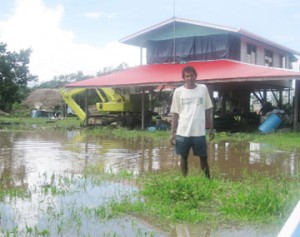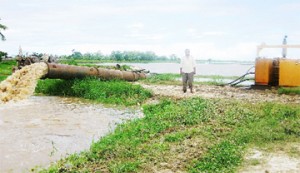-farmers blame release of water from conservancy
After three weeks of intense rainfall, residents of the Mahaica and Mahaicony Creeks who had tried desperately to keep their land dry lost the battle to the floodwaters on Thursday and are suffering losses to their crops.

When Stabroek News visited the creeks yesterday residents were complaining that they had invested a lot of money in their crops and had to “watch everything go down the drain.”
The residents were sure that the water from the Maduni sluice had been released into the creek because even after the rain stopped yesterday, the water was still “flowing.”
They told this newspaper that even though there was prolonged rainfall on Thursday that caused the water to build up fast, “it should have gone down even after the rain eased up yesterday and Friday.”

One man said that “the speed that the water coming with, I know it is coming from the sluice. The government issued notices on TV that they may have to open the water and residents must take precautions. But what precautions we must take? We plant on the ground…”
Last evening residents of Mahaica Creek went to visit the Maduni sluice and said they saw that the sluice had been opened and the water was flowing into the Mahaica Creek, and they took videos of it.
They told this newspaper by telephone after returning that, “The workers would go and open the sluice in the evening and close it back early in the morning and then they [government officials] would doubt that they opened it so we took the proof.”

When this newspaper spoke to CEO of the National Drainage and Irrigation Authority Lionel Wordsworth yesterday evening, he did not confirm that water had been released from the conservancy and said the high water levels in the Mahaica-Mahicony area were accounted for by inland rains, and water from the backlands which was coming down.
Minister of Agriculture Robert Persaud also said that as far as he knew no water had been released from the conservancy, although they wanted to keep this as an option.

Naresh Bhagwandeo of Big Biaboo, Mahaica Creek who is a large-scale rice, cash crop and cattle farmer, said that since the rainy season started three weeks ago he spent extra money to pump water out of his 10-acre of crop which included peppers, tomatoes, passion fruit and watermelon that were planted on high land.
However on Friday afternoon he gave up the fight and watched helplessly as the water covered “everything.” Frustrated with the constant flooding in the area, Bhagwandeo said he feels like “stopping this work and invest in some other business but I born and grew up in this.”

Haimchand Mahadeo, who invested $2 M in his cash crop and watermelon farm at Big Biaboo, Mahaica Creek – including on machinery to make an embankment on his farm and for labour – for over two months said, “I don’t think I can make that back at all.”
When this newspaper visited he watched sadly as the water from a trench close to where he had made the embankment, was flowing into his tomato farm.

His watermelon farm was also totally submerged on Friday and he said sadly that he would normally make $1M from his watermelon cultivation. However he was only able to sell $10,000 worth of the fruit. Further, he said that amount was not even enough to purchase one packet of seed which costs $13,000.
Among his other crops that he lost are 6000 roots of tomatoes, 300 roots of corilla, 4000 roots of sweet-peppers and 300 lime trees. He said he has pumps attached to two tractors trying to pump water out of his pepper plants that are on high ground and he is hoping that at least those would be saved.

He said because of the extensive work he had done on his farm “it does not flood with rainfall water alone…”
He said after the water recedes he would have to “dig out the land and fill it back and ah glad if government can assist with machinery to do the work.”
Pitamber Puran of Big Biaboo said he lost 2500 roots of bora that “now start to bear.” He said he works as a labourer and also catches fish for a living but at the moment he cannot do any work and was wondering how he would be able to take care of his family of five.

Over at Grass Hook, Eileen Sarju was distressed over the loss of her 600 roots of squash that had just started to flower as well as her watermelon, plantain, and 500 roots of beans and cassava.
She said she cultivated the crop two months ago and had not even started to reap when the floods came.
She said the water had also got into her kitchen and she had to move her stove and other utensils to her upper flat to cook. “Christmas Day me sons come to visit me and around 4 ’o clock the water start to come in and they help me to move some things upstairs.”

Around 11 pm, she related, she went down to check on the water and that was when she had to move the stove and other items.
Carmen Singh also of Grass Hook said she and her husband, Kuldeo Indar – who had gone to get his cattle out of the water – invested in 3500 roots of bora and “all duck out.” They planted some of the bora on high land and was at least hoping to save those but “water keep flowing in.”
She said they spent a lot of money to build up their land but “you can’t build it too much because in the dry season the crop would not grow.”
Mahaicony Creek
Kawal and his brother, L. Shrikant of Gordon Table, Mahaicony Creek who own 176 acres of land on the left bank of the creek and 270 on the right bank were about to prepare some of the land for rice cultivation and were glad that they decided against it.

However, they lost 1000 roots of boulanger. They also tried to save their goats by transporting them in a boat to a dam where they could build a temporary pen.
According to them their 220 head of cattle had to swim across the creek from the left bank to get to their land on the right bank which is a little higher.
They feel that the water would not go off the land until around April “and by the time it dry out the May/June rain gon catch we.” Kawal told this newspaper that he went to check on his boulanger plants yesterday and killed a “big” snake. He said during the last flood a snake had bitten him and he did not take the chance this time.
Rice farmer, Mahendra Persaud said he cultivated 150 acres of rice land and lost just about 100 bags. He said he had bought a few bags of seed paddy to replant but because of the continuous rainfall he did not get to. Yesterday he had to lift the seed paddy to higher ground in case he lost that too.
Nalini Persaud, also of Pine Ground, a cash-crop farmer who also trades in aquarium fish said that her bora, squash and ochro were all under water. She said too that the pond where she holds the aquarium fish along with hassar was overflowing and she lamented that “all the fish would get away.”
Over at Jasodra Mangal’s house at Pine Ground, the water had covered her bottom-flat and had entered her kitchen where she had to put extra board just to do her cooking.
The woman who had a boat under her house to move around in the floodwaters said her 30 Creole fowls had nowhere to go while her ducks were enjoying the water.
Seventy-three-year-old Dhanasari Singh said that she does not earn much as a pensioner and planted a kitchen garden for her personal use, but has lost everything.
Her daughter, Youndai Adjuder who was holidaying from California said she came home for the Christmas season but did not expect to be in so much floodwater.

Another resident, Gajraj Persaud said his 200 acres of land is the highest in the area and the flood did not bother him that much as yet. However, farmers would send their cattle on his land and they would destroy his dam.
A mobile hydraulic pump, operated by Cuffil Beharry has been installed in the Mora Point area by the Mahaica-Mahaicony-Abary/ Agricultural Development Authority to drain the water from the canal into the Mahaicony Creek since the rain started three weeks ago. This newspaper learnt that the pumping was to assist the rice farmers in that area.
Meanwhile, residents of the Abary Creek said that they are experiencing flooding and losses of cash crops and livestock.

